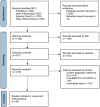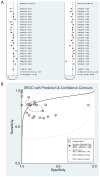Long Non-Coding RNAs as Diagnostic Biomarkers for Ischemic Stroke: A Systematic Review and Meta-Analysis
- PMID: 39766887
- PMCID: PMC11675862
- DOI: 10.3390/genes15121620
Long Non-Coding RNAs as Diagnostic Biomarkers for Ischemic Stroke: A Systematic Review and Meta-Analysis
Abstract
Ischemic stroke is a serious cerebrovascular disease, highlighting the urgent need for reliable biomarkers for early diagnosis. Recent reports suggest that long non-coding RNAs (lncRNAs) can be potential biomarkers for ischemic stroke. Therefore, our study seeks to investigate the potential diagnostic value of lncRNAs for ischemic stroke by analyzing existing research. A comprehensive literature search was conducted across the PubMed, ScienceDirect, Wiley Online Library, and Web of Science databases for articles published up to July 10, 2024. Statistical analyses were performed using Stata 17.0 software to calculate pooled sensitivity, specificity, positive likelihood ratio (PLR), diagnostic odds ratio (DOR), negative likelihood ratio (NLR), and area under the curve (AUC). Heterogeneity was explored with the Cochran-Q test and the I2 statistical test, and publication bias was assessed with Deeks' funnel plot. A total of 44 articles were included, involving 4302 ischemic stroke patients and 3725 healthy controls. Results demonstrated that lncRNAs H19, GAS5, PVT1, TUG1, and MALAT1 exhibited consistent trends across multiple studies. The pooled sensitivity of lncRNAs in the diagnosis of ischemic stroke was 79% (95% CI: 73-84%), specificity was 88% (95% CI: 77-94%), PLR was 6.63 (95% CI: 3.11-14.15), NLR was 0.23 (95% CI: 0.16-0.33), DOR was 28.5 (95% CI: 9.88-82.21), and AUC was 0.88 (95% CI: 0.85-0.90). Furthermore, the results of subgroup analysis indicated that lncRNA H19 had superior diagnostic performance. LncRNAs demonstrated strong diagnostic accuracy in distinguishing ischemic stroke patients from healthy controls, underscoring their potential as reliable biomarkers. Because most of the articles included in this study originate from China, large-scale, high-quality, multi-country prospective studies are required to further validate the reliability of lncRNAs as biomarkers for ischemic stroke.
Keywords: LncRNAs; biomarker; epigenetic; ischemic stroke; meta-analysis.
Conflict of interest statement
The authors declare no competing interests.
Figures






Similar articles
-
Diagnostic value of long noncoding RNAs as biomarkers for Ankylosing Spondylitis: A systematic review and meta-analysis.PLoS One. 2025 Jul 28;20(7):e0328249. doi: 10.1371/journal.pone.0328249. eCollection 2025. PLoS One. 2025. PMID: 40720479 Free PMC article.
-
Circulating Non-coding RNAs as Potential Biomarkers for Ischemic Stroke: A Systematic Review.J Mol Neurosci. 2022 Aug;72(8):1572-1585. doi: 10.1007/s12031-022-01991-2. Epub 2022 Apr 5. J Mol Neurosci. 2022. PMID: 35380333
-
Circulating MiRNAs as diagnostic biomarkers of lupus nephritis in patients with systemic lupus erythematosus: a systematic review and meta-analysis.Sci Rep. 2025 Jul 1;15(1):21714. doi: 10.1038/s41598-025-07860-3. Sci Rep. 2025. PMID: 40596596 Free PMC article.
-
Signs and symptoms to determine if a patient presenting in primary care or hospital outpatient settings has COVID-19.Cochrane Database Syst Rev. 2022 May 20;5(5):CD013665. doi: 10.1002/14651858.CD013665.pub3. Cochrane Database Syst Rev. 2022. PMID: 35593186 Free PMC article.
-
Identification of microRNAs as diagnostic biomarkers for acute myocardial infarction in Asian populations: A systematic review and meta-analysis.Medicine (Baltimore). 2017 Jun;96(24):e7173. doi: 10.1097/MD.0000000000007173. Medicine (Baltimore). 2017. PMID: 28614255 Free PMC article.
References
-
- Sacco R.L., Kasner S.E., Broderick J.P., Caplan L.R., Connors J.J., Culebras A., Elkind M.S., George M.G., Hamdan A.D., Higashida R.T., et al. An updated definition of stroke for the 21st century: A statement for healthcare professionals from the American Heart Association/American Stroke Association. Stroke. 2013;44:2064–2089. doi: 10.1161/STR.0b013e318296aeca. - DOI - PMC - PubMed
Publication types
MeSH terms
Substances
Grants and funding
LinkOut - more resources
Full Text Sources
Medical

